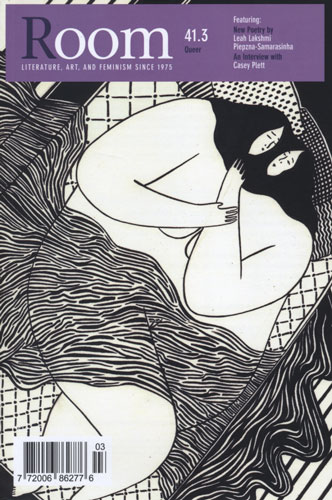Room – 2018
Room, published out of Canada, continues to live by their tagline “literature, art and feminism since 1975.” Room has come a long way from the white, middleclass, lesbian pieces of the 1970s. Editor Leah Golob is proud to say in her Editor’s Letter how “the magazine has taken greater care to feature a more nuanced, inclusive, and intersectional approach to gender and sexuality.” This issue is dedicated to queer writers who are either women or genderqueer. Through fiction, creative nonfiction, poetry, and art, this issue of Room proclaims queerness that is presented in bodies and in history, a queerness that is today and yesterday and always.
Room, published out of Canada, continues to live by their tagline “literature, art and feminism since 1975.” Room has come a long way from the white, middleclass, lesbian pieces of the 1970s. Editor Leah Golob is proud to say in her Editor’s Letter how “the magazine has taken greater care to feature a more nuanced, inclusive, and intersectional approach to gender and sexuality.” This issue is dedicated to queer writers who are either women or genderqueer. Through fiction, creative nonfiction, poetry, and art, this issue of Room proclaims queerness that is presented in bodies and in history, a queerness that is today and yesterday and always.
Leah Lakshmi Piepzna-Samarasinha, the featured writer for this issue, tackles the intersections of gender, queerness, race, and ability in her poetry. Piepzna-Samarasinha’s poem “Walking Pneumonia: A Working Class Sick Femme Prayer” is informal and brutal about confronting something as common as sickness when one is a working class femme. Every remedy is relayed next to its financial constraints. “A roasted onion and some mustard in a compress on your chest. / It’s cheap. Hit the $15 community acupuncture clinic. They will tell you to rest.” The language is simple and clear and as working class as the content. The narrator balances the need to be cheap, effective, and also take care of her body through the most difficult remedy of all to swallow: rest.
“femme infinity glosa” by hannah harris-sutro pays homage to Piepzna-Samarasinha by incorporating lines from Piepzna-Samarasinha’s poetry as the final line of each of her stanzas. harris-sutro’s piece is a love poem, and also an affirmation to the “bold girl brave girl backbone” who is at once a specific woman and could also be any and every femme. Without any capitalization, the poem reads as a river of words that have no start and no end, flowing into each other as easily and as complexly as they flow into Piepzna-Samarasinha’s words. In harris-sutro’s work, there is past queer love to draw from and present queer love to celebrate and affirm, no matter the challenges.
Sam Jowett’s poem “CisGazed” addresses gender performance by laying out their poem as a literal play. Each part of the poem begins with setting: “Int. BEDROOM” or “Ext. SUBWAY” with frequent “PAN up” and “CUT TO” moments. Jowett is the director moving the camera as the poem homes in on each single image. The narrator wakes up to some femme days, but also knows they are not on the binary. And through all the transphobia the narrator faces when simply walking out their door, they know who they are and what they see in the mirror: “seeing truth [ . . . ] reflection approving / always the first and / often the last”. The narrator knows who they are no matter the invasive questions they face. They know they are not confined to the limits of the binary.
Jane Eaton Hamilton’s short story “Phosphorescence” features a narrator restricted who feels out of body. The narrator works at the aquarium and finds she cannot relate to her partner Desi, who “is a land creature, a nerved carapace filled with earth, weighted and practical.” The narrator has known since she was a child that she is a creature of the sea. “How can I tell her that I can’t swim on land?” the narrator wonders. Queerness is saturated in these characters in refreshingly unique ways. The narrator can be in a queer relationship and still struggle to breathe and feel at peace.
Siobhan Roca Payne’s creative nonfiction essay “Beloved” is a love story told in direct address. The narrator invites you, her lover, back into history to stand atop the Roman Emperor Hadrian’s barge on the Nile. The narrator invites you to the day Hadrian’s lover Antinous drowns. Payne utilizes contemporary and humorous language to makes this history alive and queer. Though Payne openly recognizes that “Academically speaking, it’s irresponsible to ascribe our current notions of ‘gay’ and ‘straight’ to people of the past,” the narrator then says, “I am not an academic. I am a romantic. And I’m calling them queer.” Payne’s humor is beautifully balanced with the romantic notes of her piece. She invites you into a literally timeless love story.
Payne ends her essay reminding us that Hadrian and Antinous are “preserved in stone for all of antiquity and forever, or until forever ends. I know that we will be there too.” The historical continuity Payne describes is echoed in Golob’s Editor’s Letter, where she describes the published authors as being in control of their own stories. In telling their stories, the authors add to queer history. They tell the next generation of queer people that we will always and have always been here.
[roommagazine.com]





